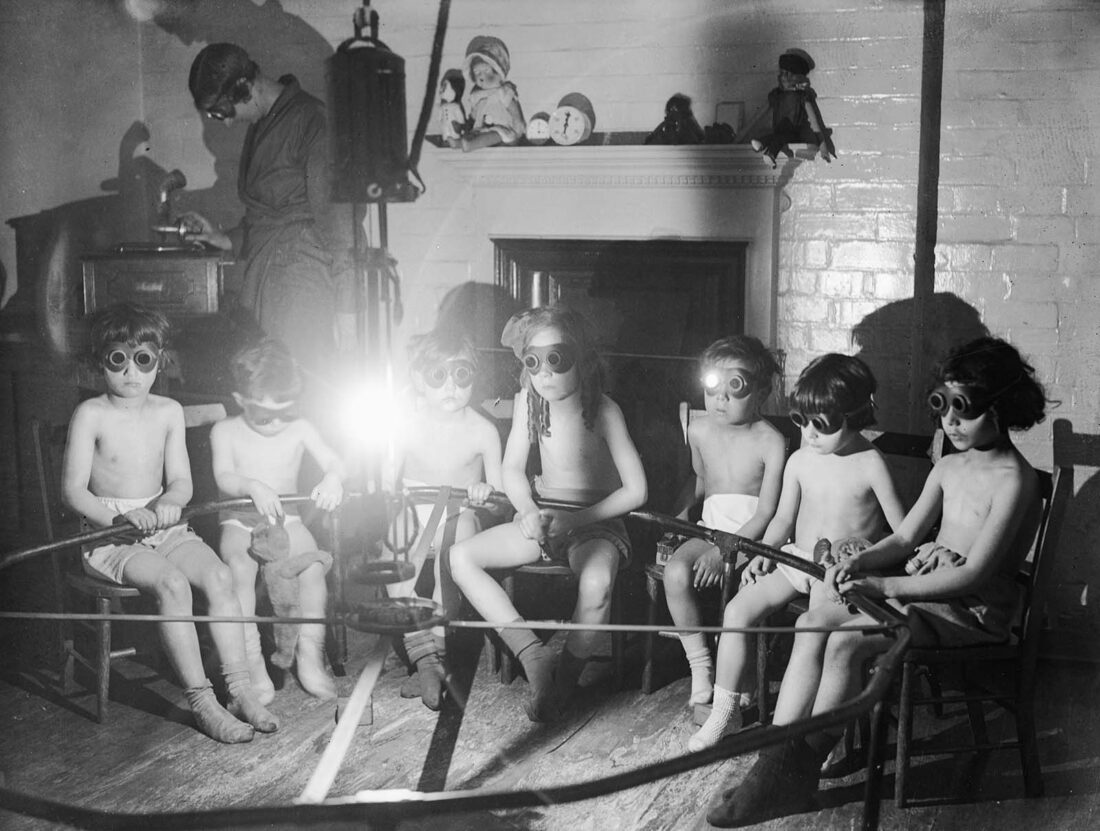Historically, light treatment has roots in ancient Egypt, India, and Greece, as “heliotherapy” (natural sunlight) for the treatment of skin diseases.
Modern phototherapy (artificial light) has its origins in the latter part of the 19th century, with the observation in 1877 that sunlight was beneficial in the treatment of anthrax infections, and then in 1890 when it was employed for the treatment of rickets. The combination of this early research in medicine, as well as the influence of Florence Nightingale with her view that …
“It is the unqualified result of all my experience with the sick that, second only to their need of fresh air, is their need of light; that, after a close room, what hurts them most is a dark room and that it is not only light but direct sunlight they want,”
was the beginning of light therapy, both as heliotherapy and phototherapy. Arnold Rikli also advocated the healing potential of light and heliotherapy, with the establishment of heliohydrotherapy centers in the 1850s in Bled, Slovenia.
Modern light therapy (phototherapy) had a marked uptake in use in medicine in Scandinavia, America, and Australia, following the pioneering work of Niels Finsen in the late 19th century, which culminated in Dr Finsen receiving the Nobel Prize for Medicine in 1903 for the treatment of tuberculosis scarring with ultraviolet (UV) light, and treatment of smallpox scarring with red light”.
The treatment spread quickly around the world. One example was Dr. John Harvey Kellogg, who traveled to Denmark to work with Finsen and introduced light boxes to his clinics in Battle Creek, Michigan in 1891. His brother, Dr. Merritt Kellogg, introduced light therapy into the newly formed Sydney Adventist Hospital, also in 1903.
There was a period after the extensive use of light in the 1930s, when phototherapy, which included UV and far-infrared (thermal) wavelengths, resulted in injury with home-use applications. This came about due to untrained persons, who without adequate considerations of dose and timing, caused burns. After Medical Board consultation in Britain, UVB light therapy was restricted to hospital use to be administered by health professionals including physiotherapists and nurses.
Treatment with light, especially UVB light, has been widely applied by physiotherapists in hospitals for dermatological conditions since the 1950s, particularly in Australia, Scandinavia, USA, England and Canada. In parallel, light treatment in hospitals for hyperbilirubinemia was used for neonatal jaundice.
Light treatment expanded after an incidental discovery in 1967 by Dr. Endre Mester who began to perform the first experiments using laser light to accelerate wound healing (as well as re-growing hair) in animals and patients Since the 1980s light was also used in the medical specialties of ophthalmology, dermatology, and cardiology. In more recent years in physiotherapy, light was mostly used as an adjunct to the management of orthopedic/rheumatological conditions.
Paradoxically, the expanded use of light in medicine (i.e. high-powered surgical lasers in dermatology, orthopedics, oncology, and ophthalmology) has been accompanied by decreased use in physiotherapy and a consequent diminishing of the knowledge and practice of light therapy for wounds and dermatological conditions by newly qualified physiotherapists.
Since the 1990s light, in the form of photobiomodulation, has been used for the management of lymphedema, including in supportive cancer care. Photobiomodulation in the form of low-level laser has been used by physiotherapists and pain doctors since the 1990s in the management of chronic pain.
The use of light has expanded into new and exciting practices including supportive cancer care, and treatment of depression, oral mucositis, retinopathy of prematurity, and cardiac surgery complications. Light is also being used in the treatment of neurological diseases, such as Parkinson‘s disease, traumatic brain injury, and multiple sclerosis. Although it has fallen somewhat out of favour over the past decades, there has been a renewed interest using modern techniques in recent times.
Reference
This article is a brief summary of the work of Liebert, A & Kiat, H. (2021). The history of light therapy in hospital physiotherapy and medicine with emphasis on Australia: Evolution into novel areas of practice. Physiotherapy Theory and Practice, 37(3), 389–400.


[…] blog was originally published here on https://history.physio/, the website of the International Physiotherapy History Association. It […]
I appreciate your dedication to writing.